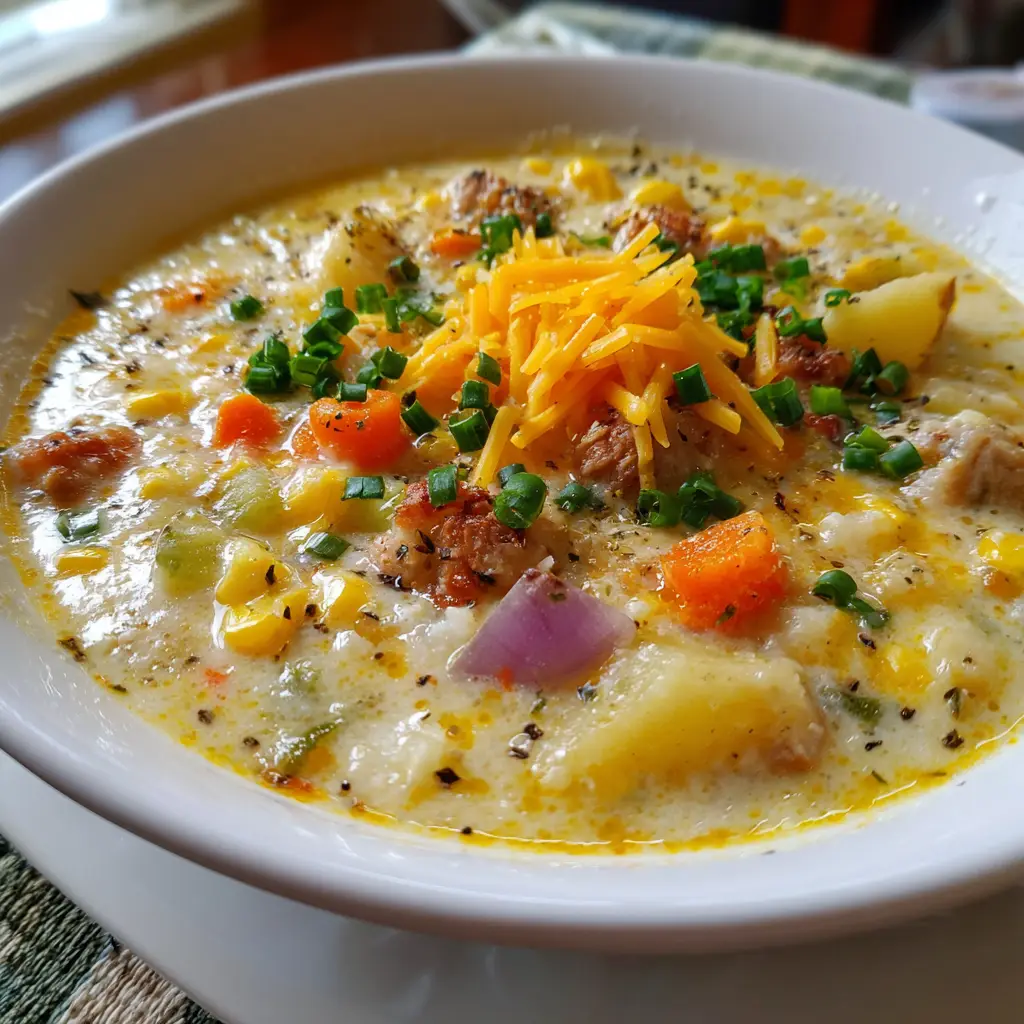Sweet Corn and Potato Chowder is a sublime celebration of humble, earthy ingredients transformed into a dish of profound comfort and elegance. This vegetarian-friendly chowder stands as a testament to the power of simplicity, where the natural sweetness of fresh corn and the hearty, grounding presence of potatoes are allowed to shine. Unlike its cream-laden, heavy counterparts, a well-made corn and potato chowder achieves its luxurious texture through a clever combination of techniques, often using the starch from the potatoes themselves as a natural thickener and pureeing a portion of the soup to create a velvety base that clings to the remaining whole kernels and vegetable chunks.
Why Is This Sweet Corn and Potato Chowder So Popular?
The enduring popularity of Sweet Corn and Potato Chowder is built upon a foundation of universal appeal and practical virtues. Firstly, it is a culinary chameleon, effortlessly adapting to dietary preferences; it is naturally vegetarian and can easily be made vegan, gluten-free, or enriched with bacon or seafood without losing its core identity. This inclusivity makes it a go-to recipe for feeding diverse groups. Secondly, it is the epitome of comfort food that doesn’t feel overly indulgent. While creamy and satisfying, its primary components are vegetables, offering a sense of wholesome nourishment. The flavor profile—a dominant, sunny sweetness from the corn balanced by the neutral starch of the potato and the savory depth of a good vegetable broth—is universally pleasing, crossing cultural and age barriers. It’s a dish that comforts a child and impresses an adult simultaneously. Furthermore, its popularity is tied to its seasonal flexibility. While it is at its absolute peak when made with fresh, sweet summer corn, it remains a delicious and accessible year-round option thanks to the reliability of frozen corn and the constant availability of potatoes. In a world of complex recipes, this chowder is a sanctuary of straightforward, achievable cooking that yields spectacular, restaurant-quality results, making every home cook feel like a master of their kitchen.
Why You’ll Love This Sweet Corn and Potato Chowder:
You will develop a deep affection for this Sweet Corn and Potato Chowder recipe because it is meticulously designed for maximum flavor with intuitive, fail-safe steps. You will love the transformative process of taking a few inexpensive, basic ingredients and creating a pot of gold that tastes far greater than the sum of its parts. The method of pureeing a portion of the chowder is a revelatory technique that you will adopt for other soups; it creates an incredibly rich and creamy texture without relying on excessive heavy cream or a heavy roux, allowing the true flavor of the corn to be the star. You will appreciate the recipe’s flexibility, encouraging you to add a personal touch—a pinch of smoked paprika, a garnish of crispy shallots, or a sprinkle of fresh herbs from your garden. This chowder is also a practical dream; it is a one-pot meal that makes for easy cleanup, it reheats magnificently, often tasting even better the next day, and it freezes surprisingly well (if you freeze it before adding the dairy). Most importantly, you will love the feeling of serving a bowl of this vibrant, golden-hued chowder. It is a dish that communicates care, warmth, and a connection to the simple, good things in life, guaranteed to garner compliments and requests for seconds.
Here’s what you’ll need:
The Aromatic & Flavor Base:
-
3 tablespoons Unsalted Butter or Extra-Virgin Olive Oil: For a rich foundation. Butter provides a classic flavor, while olive oil keeps it vegan-friendly.
-
1 large Yellow Onion, finely diced: The essential sweet, aromatic base.
-
2-3 Celery Stalks, finely diced: Adds a crucial earthy, slightly bitter note to balance the corn’s sweetness.
-
1 large Leek (white and light green parts only), halved and thinly sliced: A gentle, sweet allium that adds a subtle, sophisticated depth. Be sure to wash thoroughly to remove grit.
-
4 cloves Garlic, minced: For aromatic pungency.
-
1 teaspoon Fresh Thyme Leaves (or ½ teaspoon dried): Thyme’s floral, slightly minty flavor is a perfect complement to corn.
The Star Vegetables:
-
6 cups Fresh Corn Kernels (from about 6-8 ears): This is non-negotiable for the best flavor. The cobs are also used, so don’t discard them! Alternatively, you can use 2 (16 oz) bags of high-quality frozen corn, thawed.
-
1.5 pounds Yukon Gold Potatoes, peeled and diced into ½-inch cubes: Their buttery texture and waxy nature hold shape beautifully while contributing to a creamy broth.
-
1 large Red Bell Pepper, finely diced: Adds a pop of color, a slight sweetness, and a subtle crunch.
The Liquid & Thickening Agents:
-
4 cups Low-Sodium Vegetable Broth: The savory backbone. Using low-sodium allows you full control over seasoning.
-
2 cups Water: To cover the vegetables.
-
⅓ cup All-Purpose Flour: For the roux, which gives the chowder its foundational body. For a gluten-free version, use an equal amount of cornstarch or gluten-free flour blend.
-
1 cup Whole Milk or Half-and-Half: Adds creaminess and a touch of richness.
-
1 cup Heavy Cream: For the final, luxurious, silky finish. For a lighter version, substitute with additional whole milk or even unsweetened plain almond milk.
The Seasoning & Finishing Touches:
-
1 Bay Leaf: A classic simmering herb for depth.
-
½ teaspoon Smoked Paprika: Adds a whisper of smoke and beautiful color.
-
¼ teaspoon Cayenne Pepper (optional): Just a pinch to add a very subtle background warmth, not overt spiciness.
-
Kosher Salt and Freshly Cracked Black Pepper: To taste.
-
2 tablespoons Fresh Parsley, chopped: For a fresh, green garnish.
-
2 tablespoons Fresh Chives, sliced: Their mild onion flavor is the perfect final touch.
How to Make Sweet Corn and Potato Chowder:
Now that you have your ingredients ready, let’s dive into the steps for making this delightful Sweet Corn and Potato Chowder. It’s as easy as pie, and I promise you’ll feel like a culinary superstar!
Step 1: Milk the Corn Cobs (The Secret Flavor Weapon)
If using fresh corn, after you have cut the kernels from the cobs, place the cobs in a large pot. Add the 4 cups of vegetable broth and 2 cups of water. Bring to a simmer, then reduce the heat, cover, and let them steep for 20 minutes. This creates a profoundly corny, sweet broth that will form the soul of your chowder. After steeping, remove and discard the cobs. If using frozen corn, simply combine the broth and water in the pot and proceed.
Step 2: Sauté the Aromatics (Building the Foundation)
In a large Dutch oven or heavy-bottomed stockpot, melt the butter over medium heat. Add the diced onion, celery, and leek. Sauté for 6-8 minutes, until softened and translucent but not browned. Add the minced garlic and thyme and cook for one more minute until fragrant.
Step 3: Create the Roux (The Thickening Engine)
Sprinkle the flour over the sautéed vegetable mixture. Stir constantly and cook for about 2 minutes. This cooks out the raw flour taste and creates your roux, which will give the chowder its body. The mixture will look like a thick, clumpy paste.
Step 4: Gradually Incorporate the Liquid
Slowly, while whisking constantly, pour the prepared corn cob broth (or plain broth/water mixture) into the roux and vegetable mixture. Whisk vigorously until the roux is completely dissolved and the liquid is smooth and beginning to thicken.
Step 5: Simmer the Potatoes
Add the diced potatoes, the bay leaf, smoked paprika, and cayenne (if using) to the pot. Bring the chowder to a boil, then reduce the heat to low, cover, and let it simmer for 15-20 minutes, or until the potatoes are just fork-tender.
Step 6: Add Corn and Cook Through
Stir in the fresh (or thawed) corn kernels and the diced red bell pepper. Simmer, uncovered, for another 10-15 minutes, until the corn is tender and the potatoes are perfectly soft.
Step 7: Puree and Finalize Creaminess
Remove the bay leaf from the pot. Using a ladle, carefully transfer about 3-4 cups of the chowder (making sure to get a good mix of broth, corn, and potatoes) to a blender. Blend until completely smooth. Caution: Allow the soup to cool slightly and hold the blender lid on with a towel to prevent steam from blowing it off. Pour the pureed soup back into the pot and stir to combine. This step creates an incredibly creamy, cohesive base. Finally, stir in the whole milk and heavy cream. Warm the chowder through over low heat for about 5 minutes—do not boil. Season generously with salt and pepper to taste.
Tips for Success:
-
Never Discard the Cobs: The “corn stock” made from steeping the cobs is the single most impactful step for achieving a deep, authentic corn flavor.
-
Blending for Safety: Always be cautious when blending hot liquids. Let it cool for a few minutes and start on a low speed, or use an immersion blender directly in the pot for convenience and safety.
-
Texture is Key: Dicing the potatoes and other vegetables to a uniform size ensures even cooking.
-
Taste at the End: Potatoes and broths vary in saltiness. Always do your final seasoning with salt and pepper after the cream has been added and the soup is finished.
-
Thickness Control: If the chowder is too thick after pureeing, thin it with a bit more broth or milk. If it’s too thin, let it simmer uncovered for a few more minutes or create a quick slurry with a tablespoon of cornstarch and two tablespoons of water, then stir it in.
-
Fresh Herbs are Best: The garnish of fresh chives and parsley adds a vital burst of freshness that cuts through the richness; don’t skip it.
Equipment Needed:
-
Large Dutch Oven or Heavy-Bottomed Stockpot (6-8 quarts)
-
Sharp Chef’s Knife
-
Cutting Board
-
Measuring Cups and Spoons
-
Whisk
-
Ladle
-
Blender or Immersion Blender (Essential for the creamy texture)
Variations of Sweet Corn and Potato Chowder:
-
Vegan Corn Chowder: Use olive oil instead of butter. Substitute the milk and cream with 1 can (13.5 oz) of full-fat coconut milk. The coconut flavor is subtle and works beautifully with the corn.
-
Smoky Bacon & Corn Chowder: Begin by cooking 6 slices of diced thick-cut bacon until crispy. Remove the bacon and use the rendered fat to sauté the vegetables. Use the bacon as a garnish.
-
Southwestern Corn Chowder: Add 1 teaspoon of ground cumin and 1 (4 oz) can of diced green chiles with the potatoes. Garnish with chopped cilantro, a squeeze of lime, and a dollop of sour cream.
-
Cheesy Corn Chowder: After adding the cream, stir in 1.5 cups of shredded sharp cheddar or pepper jack cheese until melted and smooth.
-
Seafood Corn Chowder: Add 1 pound of large, raw shrimp (peeled and deveined) or diced scallops in the last 5 minutes of cooking, just until they turn opaque.
Serving Suggestions for Sweet Corn and Potato Chowder:
This chowder is a complete meal, but the right accompaniments make it unforgettable.
-
The Perfect Bread: Serve with a thick, warm slice of Crusty Sourdough, a fluffy Buttermilk Biscuit, or a warm Cornbread Muffin to soak up every last drop.
-
Salad for Contrast: A simple Arugula Salad with a lemon vinaigrette or a Classic Caesar Salad provides a crisp, peppery contrast to the creamy soup.
-
Topping Bar: Set out small bowls with extra fresh chives, crispy fried shallots, crumbled bacon, grated cheese, or a drizzle of hot sauce for a customizable experience.
-
Elegant Starter: Serve in small, pre-warmed cups or bowls as the first course for a dinner party.
Prep Time:
25 minutes
Cooking Time:
50 minutes
Total Time:
1 hour 15 minutes
Nutritional Information (Estimated per serving, serves 6):
-
Calories: ~420
-
Protein: ~9g
-
Sodium: ~650mg
-
Sugar: ~14g
-
Fat: ~22g (Saturated Fat: ~13g)
-
Carbohydrates: ~55g
-
Fiber: ~6g
Please note: Nutritional information is an estimate and can vary significantly based on the specific brands of ingredients you use and any modifications, such as using milk instead of cream.
FAQs about Sweet Corn and Potato Chowder:
Q: Can I use frozen corn instead of fresh?
A: Absolutely. High-quality frozen sweet corn is an excellent and convenient substitute. While you’ll miss the opportunity to make “corn stock” from the cobs, the final chowder will still be delicious. Do not thaw completely if using the pureeing method, as the slight frozenness can help with the blending process.
Q: How can I store and reheat leftovers?
A: Store cooled chowder in an airtight container in the refrigerator for up to 4 days. Reheat gently on the stovetop over low heat, stirring occasionally. Do not boil, as this can cause the dairy to separate. If it has thickened too much, add a splash of broth or milk to loosen it.
Q: Can I freeze this chowder?
A: You can, but with a caveat. Cream-based soups can separate and become grainy upon thawing. For best results, freeze the chowder before adding the milk and cream. When ready to eat, thaw, reheat, and then stir in the dairy.
Q: My soup is too thin. What did I do wrong?
A: The soup may not have been simmered long enough after pureeing, or your potatoes may have been less starchy. The easiest fix is to create a cornstarch slurry (1 tbsp cornstarch + 2 tbsp cold water) and whisk it into the simmering soup until it thickens.
Q: Is there a way to make this without a blender?
A: Yes, but the texture will be different. You can use a potato masher to mash some of the potatoes and corn directly in the pot to thicken the broth. It will be more rustic and chunky rather than velvety and smooth.
Final Thoughts:
Sweet Corn and Potato Chowder is more than just a meal; it is a bowl of pure, unadulterated comfort that captures the essence of sunshine and soil in every spoonful. This recipe guides you through a process that honors the ingredients, extracting maximum flavor through techniques like creating a corn cob stock and using a partial puree to achieve a texture that is both luxurious and wholesome. It is a dish that is deceptively simple, quietly impressive, and deeply nourishing for both body and spirit. It reminds us that the finest cooking doesn’t require a long list of exotic ingredients, but rather a thoughtful approach to the staples we have on hand.






